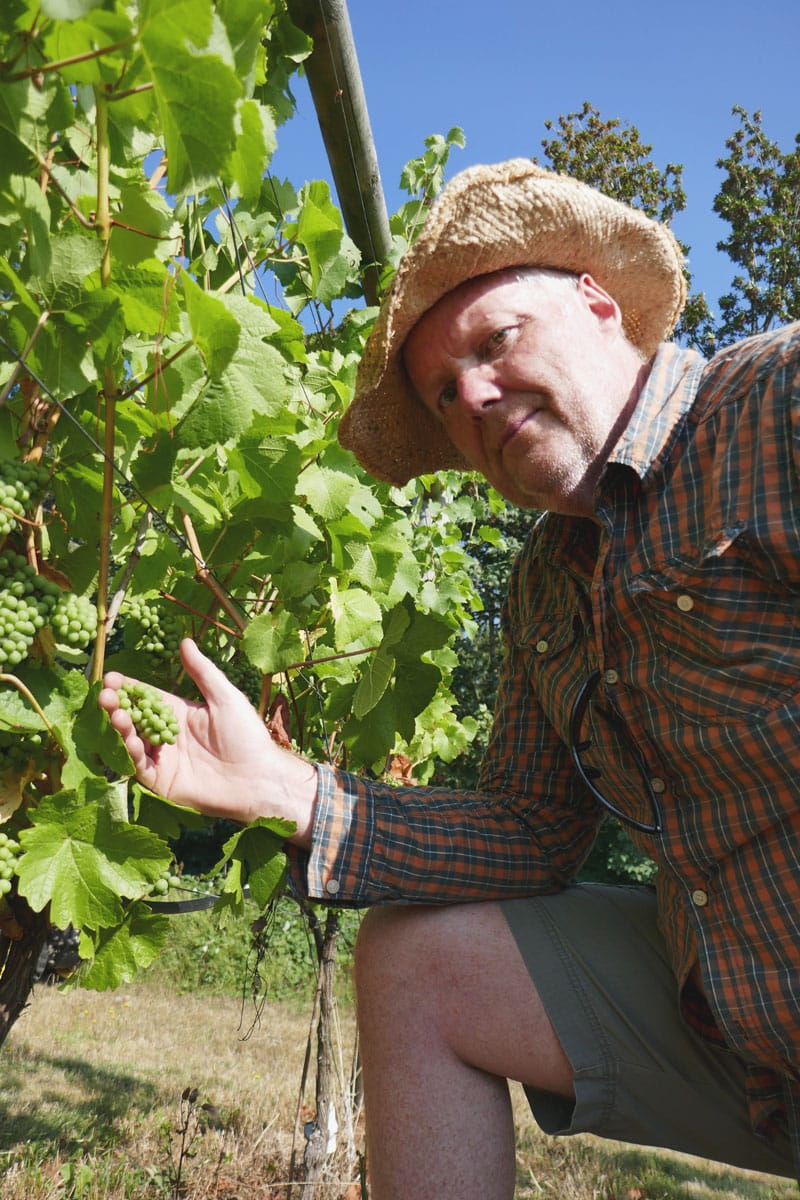
Wine Culture Magazine

Dr. John Volpe examines grapes at Unsworth Vineyards in the Cowichan Valley, part of his climate research project. Vineyards. Supplied photo
As every winemaker knows, a critical decision in the vineyard is choosing the perfect time to pick.
That’s the challenge facing growers in Vancouver Island’s Cowichan Valley, a fledgling wine region with unique terroir. But this summer there were scientists among the vines, testing some popular vineyard management techniques and quantifying the results in their lab.
“When I spoke with Island growers, the biggest questions were around ripening—when to pick and how to manage the vineyard to maximize flavour,” says Dr. John Volpe, a University of Victoria ecologist who is leading the team working at Unsworth Vineyards, Blue Grouse Estate Winery and Enrico Winery.
Grape growers use various means to enhance quality and ripeness, whether it’s thinning clusters to concentrate the plant’s resources or removing leaves to expose the fruit to more sunshine. And while these viticulture practices are popular in many parts of the world, Volpe says there’s been little “empirical evaluation” or science to measure the molecular changes in the grapes or the result in the finished wine.
“We will be using mass spectrometry to measure the diversity of aroma- and flavour-producing compounds in the grapes,” he says. “Then we will be making wine to determine the cost and benefit to winegrowers. There are a huge number of research questions that need to be answered.”
It’s all about sugar levels and “physiological” or “phenolic” ripeness—that sweet spot in maturation that can make a significant difference in the glass. The typical testing of sugar (Brix) and acidity (pH) in the lab, with physical observations of stem and seed colour, is helpful but often subjective, says Volpe.

Pinot Gris grapes. istockphoto.com photo
Researchers will quantify the changes in Pinot Gris grapes using gas chromatography-mass spectrometry (GC-MS) to identify scientific markers of physiological ripeness. After the harvest this fall, the researchers will be making “at least a dozen different wines” in their lab, Volpe says. Those wines will then be evaluated by sensory panels to determine how vineyard management techniques translate into perceived quality in the glass.
Vancouver Island is on the cusp of something big.
The researchers are working with the Wine Island Growers Association and the Investment Agriculture Foundation of B.C., with funding from the provincial government and Agriculture and Agri-Food Canada. Andrew Watts, the vineyard manager at Unsworth, will use this research as the foundation for his master of science thesis in environment studies.
Volpe has long focused his research on links between ecological and social responsibility, especially in the area marine conservation, fisheries and aquaculture. The shift to the island’s fledgling wine industry reflects his interest in wine (Volpe is also a certified sommelier) and the effects of climate change on local ecology.
Temperatures are warming quickly in the Cowichan Valley. Scientists predict a 28 per cent increase in the length of the growing season by 2050 and a 49 per cent increase in growing degree days. At the same time, the amount of summer rainfall is expected to decrease by 17 per cent, putting additional strain on already stressed water supplies.
“Terroir, as it relates to wine, is really the co-evolution of a people and their place, a result of trial and error over time,” Volpe says. The research aims to fast track that knowledge base, to help local wineries optimize production as growing conditions evolve.
“Vancouver Island is on the cusp of something big,” he adds. “It’s a terrific opportunity for UVic to become a potential partner in the Island wine scene, and a wonderful test arena for some of the broader ideas exploring the overlap between ecology and food and wine production.”

Cinda Chavich is a Victoria-based food and wine journalist. She covers food and drink for YAM, EAT and TasteReport.com, has written for The Globe and Mail, WestJet and Maclean’s, and is author of The Waste Not, Want Not Cookbook.

Cinda Chavich is a Victoria-based food and wine journalist. She covers food and drink for YAM, EAT and TasteReport.com, has written for The Globe and Mail, WestJet and Maclean’s, and is author of The Waste Not, Want Not Cookbook.
@ Vitis Magazine